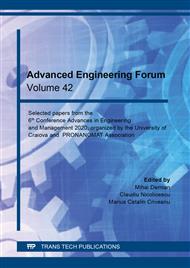p.50
p.57
p.63
p.71
p.79
p.85
p.91
p.99
p.107
Experimental Stand to Investigate the Injection Process in Diesel Engines
Abstract:
The objective of this paper is to investigate the fuel injection system in diesel engines by using inline pumps. In a diesel engines, the fuel injection pressure plays an important role in the combustion process in order to obtain high performance and low fuel consumption. The experiments in this paper are been performed on a 6 cylinder inline pump which is actioned by an electric motor with variable r.p.m.-s The quantity of the fuel injected by each injector is measured function of time and the speed of electric motor. The experiments show the degree of non-uniformity of the fuel delivered by the pump to injectors.
Info:
Periodical:
Pages:
79-84
Citation:
Online since:
September 2021
Authors:
Keywords:
Price:
Сopyright:
© 2021 Trans Tech Publications Ltd. All Rights Reserved
Share:
Citation:


